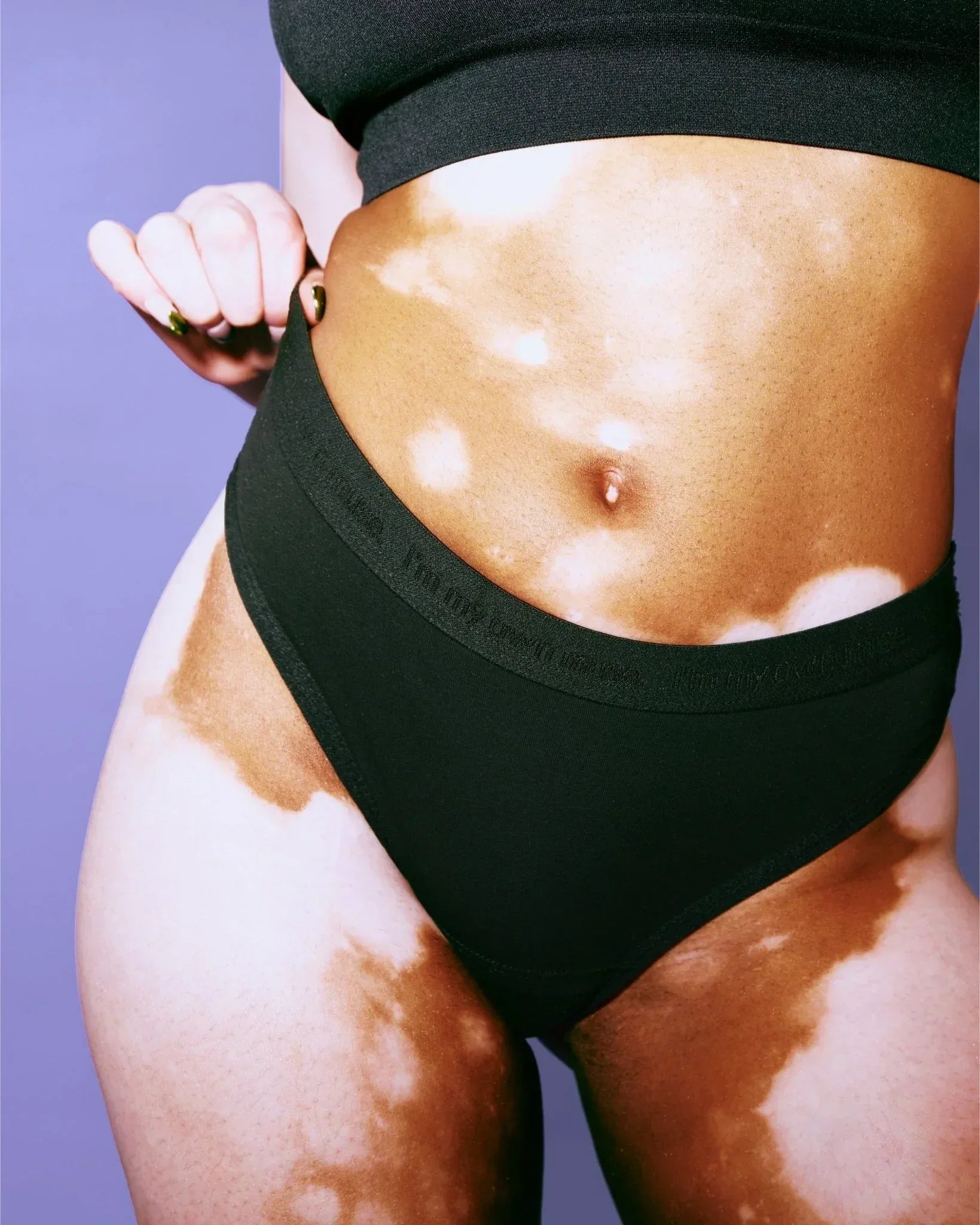First, let's talk real! It doesn't matter whether it's yellow, white, green or brown discharge. It's nothing to be ashamed of - just to make that clear. After all, we always hear the wildest stories.
Our vaginal discharge has an important protective function and keeps disease-causing germs at bay. So just let it flow! And don't panic! There are products that can help you.
So now let’s take a closer look at the whole thing (literally 😉)
Summary
Vaginal discharge is not uncommon and nothing to be ashamed of !
Your discharge is white ? That sounds normal !
Is your discharge brown , yellow or green ? This can be a sign of an illness, but it doesn't have to be.
Table of contents
Contents
1. What is discharge anyway?

First, the good news: vaginal discharge is nothing unusual – every woman has it. Well, we were lucky again. Phew!
Want some facts?
Discharge consists primarily of cells from the vaginal mucosa and a secretion produced by the glands on the cervix (cervical glands). In principle, discharge is not an unwelcome guest that we want to get rid of as quickly as possible; it cleans and protects . And it does that quite well.
The color, smell or consistency of the discharge can reveal a lot about us and our state of health. Normally, the discharge is whitish, odorless and not associated with any pain.
🚨ALARMAAAA!!!
As soon as your vaginal discharge changes in an unpleasant way, alarm bells should ring.
This could be a real warning sign! It can often be caused by a nasty infection with bacteria, fungi or viruses - especially bacterial vaginosis and vaginal yeast infections.
Other symptoms that often occur are itching, burning or pain. Now it's time to go to the doctor. They can help you and vaginal infections can usually be easily controlled with appropriate medication.
2. Brown discharge
If your discharge is brownish , it can actually be a sign of illness – but it doesn’t have to be!
Especially during ovulation, brown discharge can occur due to hormonal changes in your body . This is completely normal, as the estrogen level rises and triggers the release of the egg from the ovaries.
Brown discharge is also completely normal before or after your period. In short: blood that is no longer quite fresh turns brown. Bam! Another cause of brownish discharge can be early pregnancy .
If your brown vaginal discharge is not itchy, smells bad or is green-brown, there is no need to panic. However, if it is accompanied by abdominal pain, fever and/or itching, this is often a sign of an illness or hormonal imbalance . This should definitely be treated by a specialist!
3. Yellow discharge - That's why!
A yellowish discharge indicates that an immune reaction against a pathogen has already occurred.
This is because the yellow discharge is caused by the accumulation of leukocytes (parts of the immune system) at the infected part of the body.
Other symptoms, such as burning when urinating and a fishy smell , may indicate an infection.
There are many causes and it is important to seek medical advice. Chlamydia, gonorrhea or trichomonads are often responsible for the yellowish discoloration.
4. Greenish discharge - What is that?!
If you notice greenish discharge, then the alarm level is red.
This is often a sign of an infection. Various fungi, bacteria, and even sexually transmitted diseases such as gonorrhea could be responsible.
Therefore, if you experience additional pain or an unpleasant smell, you should go to the doctor!
5. White discharge
Did you know : Discharge is also responsible for the light stains in your underwear. Find out what this is all about here .
Okay, okay, after the information above, you might think that discharge is a problematic sign. But it really isn't always. I promise!
As already explained, white discharge is COMPLETELY NORMAL . And it helps your vagina to clean itself. Of course, it sometimes comes out more for some than for others, but the color and consistency should be at the same level. Now let's get to the point, what does that mean?

6. What does discharge before a period look like?
Did you know : Wet panties before your period are not uncommon! Many women are affected by this. Find out what is normal and when you need to see a gynecologisthere .
The color and consistency of vaginal discharge changes due to the influence of hormones , i.e. depending on the time in the menstrual cycle.
Shortly before your period, the discharge is usually whitish or yellowish and has a thick, sticky consistency. Almost lumpy. Side fact - One of the reasons for this is to create an impermeable barrier for the sperm, because we are less fertile in this phase of the cycle. It can even be that the discharge before your period is so little that you almost wish you had a little moisture back down there - this is due to the low estrogen.
During the fertile phase around ovulation, estrogen causes the cervical mucus to become very thin and viscous.
The closer you get to ovulation , the better the quality of your discharge will be: it will become clearer, glassier, and less color.
After your period , you may notice that your discharge has a slight yellow tint or white streaks. This is also completely normal and the fault of your hormones!
7. What can I do about discharge?
If you're thinking: Vaginal discharge? Nope, not today , we can really understand that.
There's not really anything you can do about it. But we still have a tip:
To protect your hot panties (whether yellow, greenish, white or brown discharge) or just to feel safe - organic panty liners are the thing! Every day. Is that healthy? No! It is not recommended to use panty liners every day. If the panty liners are not changed every 3-5 hours, they can quickly create an environment for bacteria and viruses. This does not happen with breathable discharge underwear! Daysics® with their slightly absorbent insert are designed to prevent the feeling of wet crotch caused by natural discharge in everyday life. Your Daysics® have an extra short and thin insert - for an invisible look - and, unlike conventional panty liners, do not impair breathability. Try it out!












































